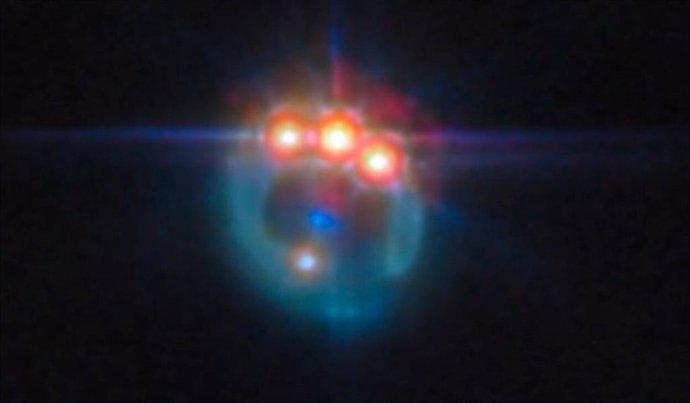Gravitational lensing effect on the quasar RX J1131-1231 – THAT
8 Jul. () –
This new image from the James Webb Space Telescope shows the gravitational lensing effect of the quasar RX J1131-1231, located 6 billion light-years away in the constellation Crater.
At the top of the ring are three very bright spots with diffraction spikes coming out of them, one next to the other: They are copies of a single quasar in the galaxy with a lens effect, doubled by the gravitational lensing effect. At the center of the ring, the lensing elliptical galaxy appears as a small blue dot, ESA reports.
It is considered one of the best gravitationally lensed quasars discovered to date, as the foreground galaxy blurs the image of the background quasar into a bright arc. and creates four images of the object.
The gravitational lensing effect, first predicted by Einstein, offers a rare opportunity to study regions close to the black hole in distant quasars, by acting as a natural telescope and magnifying the light from these sources. All the matter in the Universe warps the space around it, and larger masses produce a stronger effect.
Around very massive objects, such as galaxies, light passing by follows this warped space, and appears to deviate from its original path by a clearly visible amount. One consequence of gravitational lensing is that it can magnify distant astronomical objects, allowing astronomers to study objects that would otherwise be too faint or distant.
Measurements of X-ray emission from quasars can provide an indication of the rotation rate of the central black hole, and this gives researchers important clues about how black holes grow over time. For example, if a black hole grows primarily from collisions and mergers between galaxies, it should accrete material into a stable disk, with the constant supply of new material from the disk should result in a rapidly spinning black hole.
On the other hand, if the black hole grew through many small accretion episodes, it would accumulate material from random directions. Observations have indicated that the black hole in this particular quasar is spinning at more than half the speed of light, suggesting that this black hole has grown through mergers, instead of drawing material from different directions.
This image was captured with Webb’s Mid-Infrared Instrument (MIRI) as part of an observational program to study dark matter. Dark matter is an invisible form of matter that accounts for most of the mass in the Universe. Webb’s observations of quasars are allowing astronomers to investigate the nature of dark matter on smaller scales than ever before.




![[Img #74661]](https://thelatestnews.world/wp-content/uploads/2024/12/The-power-of-ultrasound-150x150.jpg)








![[Img #74661]](https://thelatestnews.world/wp-content/uploads/2024/12/The-power-of-ultrasound-300x200.jpg)


Add Comment